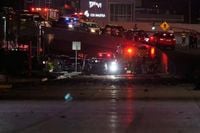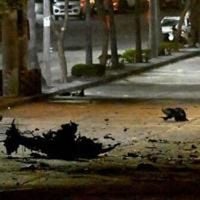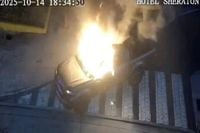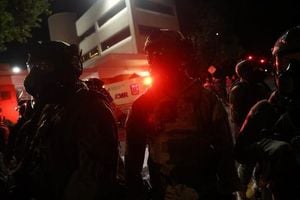On the evening of October 14, 2025, the bustling city of Guayaquil, Ecuador, was jolted by a violent explosion that shattered the calm outside Mall del Sol, the city’s main shopping center. According to reports from BBC and the Associated Press, a pickup truck loaded with explosives erupted in flames, killing a taxi driver parked nearby and injuring at least two other bystanders. The blast sent shards of metal flying, damaged nearby restaurants and stores, and broke windows in the vicinity, turning an ordinary Tuesday into a scene of chaos and fear.
Witnesses described the terrifying moments leading up to the explosion. The vehicle, parked in a busy commercial area surrounded by luxury hotels and packed with evening shoppers, caught fire before detonating minutes later. “We’re evacuating all of the buildings as a precaution,” said Maj. Jorge Montanero of the Guayaquil fire department to local television station Ecuavisa, adding that police were inspecting all vehicles in the area to ensure no further threats remained. “We don’t know, but a normal car doesn’t blow up like that,” he remarked, emphasizing the abnormal and sinister nature of the event.
The investigation quickly revealed that the explosion was no accident. Ecuador’s Interior Minister John Reimberg announced that police had discovered four explosive devices inside the remains of the truck. In a chilling detail, photos posted by Reimberg on X showed an old mobile phone, wires, and plastic tubing—clear evidence of a professionally manufactured bomb. Reimberg did not mince words, blaming the attack on criminal gangs intent on sowing chaos. “The devices were professionally manufactured by criminal groups aiming to sow chaos,” he wrote on X.
Authorities wasted no time responding to the immediate threat. Police found a second car containing explosives parked nearby and carried out a controlled detonation to neutralize the danger. The area was swiftly cordoned off, and buildings were evacuated as a safety measure. The Attorney General’s Office stated that it had launched a full investigation, interviewing witnesses and reviewing surveillance camera recordings to piece together exactly how the attack unfolded and to identify those responsible.
The aftermath of the explosion left the city on edge, but the violence did not stop there. Less than 24 hours later, on October 15, two more explosions rocked bridges in different parts of Ecuador. According to AP, explosives were placed on bridges in Naranjal, about 290 kilometers southwest of the capital Quito, and on a bridge connecting the provinces of Azuay and El Oro in the south. Transportation Minister Roberto Luque described these acts as “terrorism,” noting that the explosives were intended “to block traffic.” While no casualties were reported from the bridge blasts, the roads remained closed due to significant damage and the risk of collapse. Images released by local media showed twisted metal, rubble, and shattered bus windshields—a stark reminder of the attackers’ intent to disrupt daily life and instill fear.
Interior Minister Reimberg accused “Los Lobos,” one of Ecuador’s largest criminal gangs and designated a foreign terrorist organization by the United States, of orchestrating the attacks. He also pointed to dissidents from the Revolutionary Armed Forces of Colombia (FARC), specifically the Oliver Sinisterra Front, as being involved. Reimberg explained that the attacks followed recent security operations in northern Ecuador in which authorities destroyed illegal mining operations and detained ex-FARC members. The government offered a reward for information leading to the capture of those responsible, underscoring the seriousness with which officials are treating these coordinated acts of violence.
The mayor of Guayaquil, Aquiles Álvarez, linked the shopping mall blast to previous attempted attacks, suggesting that the “terrorist group” behind them aimed to pressure authorities into releasing jailed members. This assertion is not without context: Litoral prison, located in Guayaquil, is notorious as a stronghold for some of Ecuador’s most feared jail gangs. From behind bars, these groups exert control over much of the country’s drug trafficking, fueling a surge in violent crime and murder rates. The government of President Daniel Noboa has responded by declaring a state of “internal armed conflict” and officially designating several gangs as terrorist organizations.
President Noboa, addressing the nation on October 15, struck a defiant tone. “The country cannot back down before people who want to terrorize Ecuadorian families,” he declared, signaling an unwavering commitment to confront the criminal networks head-on. The attacks, he said, would not deter the government from its mission to restore order and security.
The recent explosions are part of a broader wave of violence that has engulfed Ecuador in recent years. Once considered one of the more peaceful countries in South America, Ecuador has seen criminal enterprises shift their drug smuggling operations from more heavily militarized nations like Colombia to its own borders. The result has been a sharp increase in car bomb attacks and targeted assassinations. In March 2025, a vehicle exploded outside Ecuador’s largest and most dangerous prison on the outskirts of Guayaquil, killing a prison guard. The bomb was attributed to a criminal network, and similar attacks have continued to plague the country since early 2021.
The scale and sophistication of these attacks have raised alarms among both officials and everyday citizens. Guayas province Governor Humberto Plaza did not hesitate to label Tuesday’s explosion “terrorism plain and simple,” promising that police would find and prosecute those responsible. “We’re going to grab them and they’re going to pay and these people are going to be prosecuted for terrorism,” he said, reflecting the determination of local authorities to bring the perpetrators to justice.
As the investigation continues, Ecuador’s government faces mounting pressure to curb the influence of criminal gangs and restore a sense of safety to its cities. The Attorney General’s Office, with support from local and national police, is reviewing surveillance footage and interviewing witnesses, while the public is urged to come forward with any information that could aid in the capture of those behind the attacks.
The violence has also taken a toll on the nation’s psyche. The explosions have disrupted daily life, closed key transportation routes, and left communities in mourning. The taxi driver killed in Guayaquil was simply in the wrong place at the wrong time—a stark reminder of the indiscriminate nature of the violence gripping the country.
With bridges damaged, roads closed, and a population on edge, Ecuador stands at a crossroads. The government’s resolve to confront criminal gangs is clear, but the challenge ahead is formidable. The recent attacks have underscored the urgent need for effective security measures and international cooperation to dismantle the networks fueling the violence. For now, Ecuadorians are left to pick up the pieces and hope that peace can be restored to their streets and neighborhoods.






